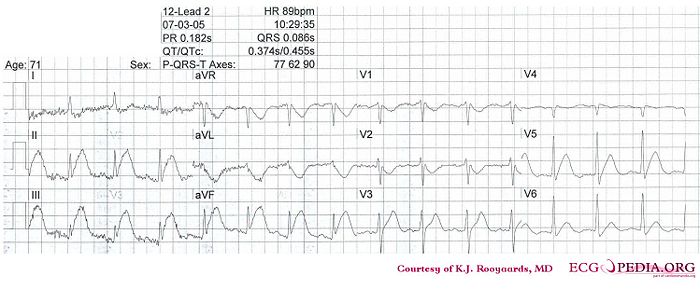Answer MI 16: Difference between revisions
Jump to navigation
Jump to search
m (New page: thumb| The ECG * Following the 7+2 steps: **Rhythm ***'''This is a regular rhythm and every QRS complex is preceded by a p wave. The p wave is positive in II,III, an...) |
(corrected st elevation in avl v1-v2 to st depression in those leads) |
||
| (2 intermediate revisions by one other user not shown) | |||
| Line 1: | Line 1: | ||
[[Image:KJcasus5.jpg|thumb| | {{Case| | ||
|previouspage= MI 15 | |||
|previousname= MI 15 | |||
|nextpage=MI 17 | |||
|nextname=MI 17 | |||
}} | |||
'''Where is this myocardial infarction located?''' | |||
[[Image:KJcasus5.jpg|700px|thumb|left|ECG MI 16. Click on image for enlargement.]] | |||
{{clr}} | |||
==Answer== | |||
* Following the 7+2 steps: | * Following the 7+2 steps: | ||
**Rhythm | **Rhythm | ||
| Line 14: | Line 24: | ||
***'''No pathologic Q waves. QRS duration < 0.12 seconds thus no bundle branch block is present. No left ventricular hypertrofy: S in V1 + R in V5 < 35mm.''' | ***'''No pathologic Q waves. QRS duration < 0.12 seconds thus no bundle branch block is present. No left ventricular hypertrofy: S in V1 + R in V5 < 35mm.''' | ||
**ST morphology | **ST morphology | ||
***'''Evident ST elevation in II,III, and AVF and also in V5. ST- | ***'''Evident ST elevation in II,III, and AVF and also in V5. ST-depression in AVL and V1-V2.''' | ||
**Compare with the old ECG (not available, so skip this step) | **Compare with the old ECG (not available, so skip this step) | ||
**Conclusion? | **Conclusion? | ||
'''Acuut Inferior-Posterior Myocardial Infarction''' | '''Acuut Inferior-Posterior Myocardial Infarction''' | ||
{{clr}} | {{clr}} | ||
Latest revision as of 20:14, 29 March 2012
| This page is part of Cases and Examples |
Where is this myocardial infarction located?
Answer
- Following the 7+2 steps:
- Rhythm
- This is a regular rhythm and every QRS complex is preceded by a p wave. The p wave is positive in II,III, and AVF and thus originates from the sinus node. Conclusion: sinus rhythm.
- Hartfrequency
- Use the 'count the squares' method (a bit less than 3 large squares ~> 300-150-100), thus about 90 bpm.
- Conduction (PQ,QRS,QT)
- PQ-interval=0.16sec (4 small squares), QRS duration=0.10sec, QT interval=360ms
- Hartaxis
- Positive in I, II, III, and AVF. Thus a normal heart axis.
- P wave morphology
- The p wave is difficult to assess, because of the (electrical) interference, but does not seem fulfill the criteria for left or right atrial dilatation.
- QRS morphology
- No pathologic Q waves. QRS duration < 0.12 seconds thus no bundle branch block is present. No left ventricular hypertrofy: S in V1 + R in V5 < 35mm.
- ST morphology
- Evident ST elevation in II,III, and AVF and also in V5. ST-depression in AVL and V1-V2.
- Compare with the old ECG (not available, so skip this step)
- Conclusion?
- Rhythm
Acuut Inferior-Posterior Myocardial Infarction
